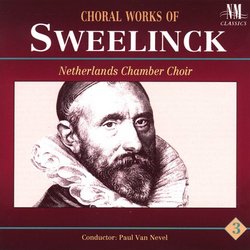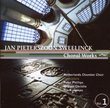| All Artists: Netherlands Chamber Choir Title: Jan Pieterszoon Sweelinck: Choral Works of Sweelinck, Vol 3 Members Wishing: 0 Total Copies: 0 Label: Nm Classics Original Release Date: 2/20/2007 Release Date: 2/20/2007 Genre: Classical Style: Opera & Classical Vocal Number of Discs: 1 SwapaCD Credits: 1 |
Search - Netherlands Chamber Choir :: Jan Pieterszoon Sweelinck: Choral Works of Sweelinck, Vol 3
 | Netherlands Chamber Choir Jan Pieterszoon Sweelinck: Choral Works of Sweelinck, Vol 3 Genre: Classical
|
Larger Image |
CD DetailsSimilar CDs |
CD ReviewsAnother side of Sweelinck Eddie Konczal | 06/01/2007 (4 out of 5 stars) "Jan Pieterszoon Sweelinck (1562-1621) is probably best remembered today for his innovative keyboard compositions, which gave rise to the fugue form and helped define the beginning of the Baroque era. Sweelinck's mastery of earlier forms is evident in his choral works, which have been captured in a series of recordings by the Netherlands Chamber Choir.
Sweelinck wrote more conservatively for sacred polyphony than he did for keyboards. This was somewhat inevitable since the Catholic Church began discouraging stylistic advances in church music during the mid-16th century. However, Sweelinck occasionally finds room to innovate within the restrictions of the genre. For example, declamatory sections of "Psalm 109" signal the trend towards the chorus-style singing found in early opera and sacred oratorio. At other times, Sweelinck seems to reach farther into the past than his contemporaries; for instance, the melismatic melodies found in "Yeux qui guidez mon ame" recall the style of Busnoys (c. 1430-1492). The performance of the Netherlands Chamber Choir, under the direction of Paul Van Nevel, is quite impressive. The production values are a bit lackluster and uneven; the 1992 recording might benefit from a remastering job. With these works, Sweelinck successfully aspires to the Renaissance ideal of conveying an otherworldly beauty through the interplay of vocal lines. For the most part, his achievements are well served here." |

 Track Listings (12) - Disc #1
Track Listings (12) - Disc #1
